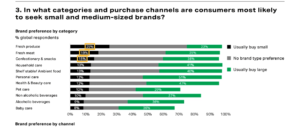How Small Independent CPG Brands Use PR to Compete
If you’re a smaller consumer brand, it might feel impossible to compete with the big guys. But according to Nielsen, in the United States “manufacturers outside of the top 100 have contributed to 52% of their region’s annual fast moving consumer goods (FMCG) growth,” that’s an incredibly promising trend for any consumer product, from skincare to cannabis. But the challenges to increasing market share aren’t imagined. In some categories, especially consumables, over 50% of consumers have no brand preference. This underscores the importance of small, independent CPG brands to invest in branding with awareness and loyalty strategies. Neilsen IQ has done some fantastic research for small, independent DTC and CPG brands.

69% of consumers are actively looking for new and trendy CPG products. Tapping into current trends is a key way to appeal to this audience. Whether the brand is launching, or already launched, there are always PR opportunities to increase sales by driving awareness and loyalty. The key takeaway on all the most recent Neilsen data: premiumization is absolutely key for small, independent CPG brands.
Driving Awareness for Small Consumer Brands
When Snapple tea was a small independent brand, it relied on PR, including crazy stunts with two ambitions in mind: acquisition and sales. When they were acquired by Quaker Oats, the PR stunts stopped and sales decreased. In fact, PR is often responsible for trends that drive consumers. Before CBD, a wellness ingredient that almost everyone now knows was allowed to advertise, it relied on firms like Avaans Media to create PR campaigns that educated consumers and created awareness for their brands. PR is almost single-handedly responsible for launching CBD into the public’s general knowledge. Other wellness products have benefited from PR, including melatonin.
Independent brands often turn to PR because while PR is an investment, it’s still more affordable than many other branding initiatives such as advertising, especially when you include videography costs. Facebook is famous for launching thousands of new DTC brands, but of late, many independent CPG brands are finding Facebook’s advertising to be less effective. Ambitious consumer product brands are turning to PR in ever greater numbers to reach consumers, and stay in front of buyers. A PR campaign can reach hundreds of billions of annual impressions. Is it any wonder that everyone from new consumer products to old standbys is moving dollars to PR?
New CPG brands can use PR to validate the brand. An upfront burst of PR is a powerful trust indicator. Many consumer brand startups showcase PR wins on their website and in advertising as a way to increase consumer trust. Independent boutique products use PR to nail their launch because they need to appeal directly and immediately to their consumer. As Nielsen notes in small brand, “There is little room for error in small launches. Nailing your activation requires planning and strategic execution. Whatever your differentiation—hitting your target, justifying your premium or communicating a new usage occasion—it must land, and land well,”
Driving Loyalty for Independent CPG Brands
If your consumer brand isn’t exactly new, but also isn’t a household name, then using PR to increase loyalty and awareness is effective. 25% of consumers are mainstream followers who sometimes try new products, but don’t seek them. This is a critical audience to penetrate. If you’re broadening your audience to this important, but slightly elusive group, you want to make sure your customer product reviews are solid, and that your early PR had at least 1-2 tier 1 press hits so you can use the ever-so-important social proof to lure this audience in. Good PR also allows existing customers to have their choice validated and is a great opportunity for them to sing your praises to their friends.
But that’s not the only way PR helps early and mid-stage CPG brands. PR helps your customers see you understand who they really are. Bob’s Red Mill used PR to improve its already stellar reputation through purpose-driven storytelling. Not only does PR help new consumers find your product, but it also reinforces the good choice your current customers have made. A good PR firm will help you identify ways to differentiate and to secure brand-improving earned media.







